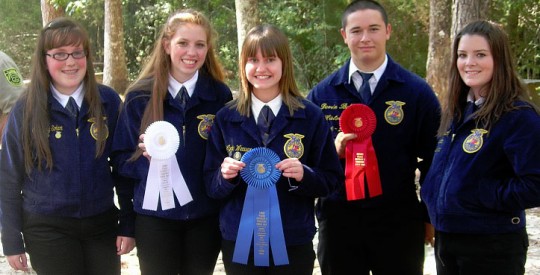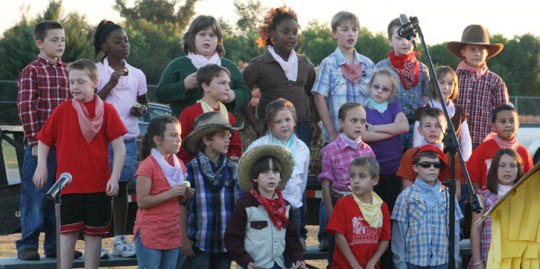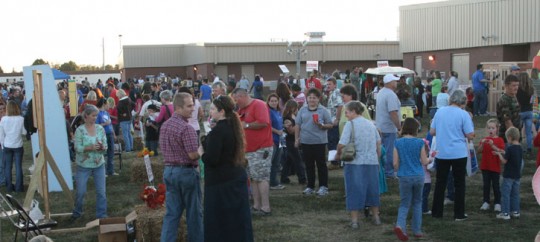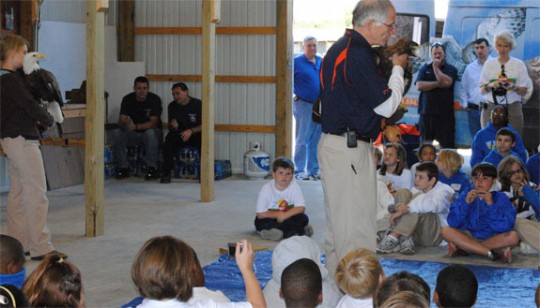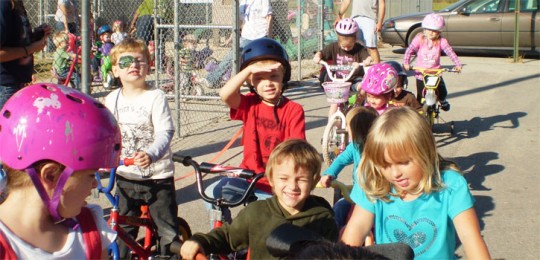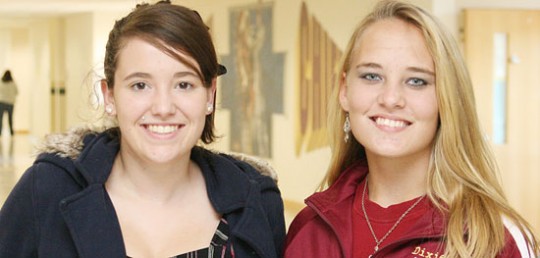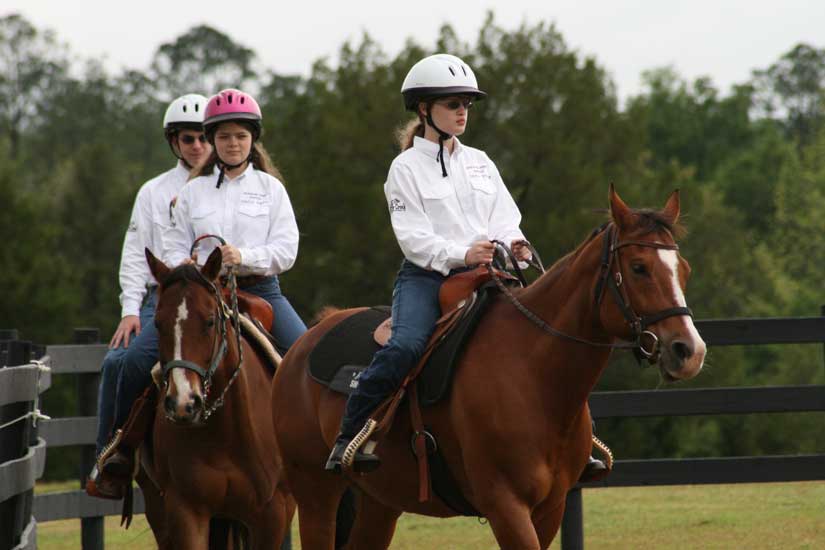FFA Students Compete In Forestry Career Development Event
October 18, 2010
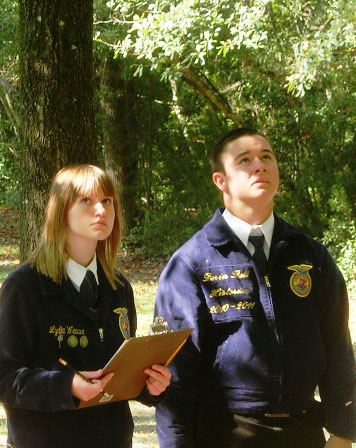 Five Northview High School FFA members recently took part in the District Forestry Career Development event at Ponce de Leon Springs State Park in Marianna.
Five Northview High School FFA members recently took part in the District Forestry Career Development event at Ponce de Leon Springs State Park in Marianna.
Northview FFA Team members participating were Courtney Solari, Stephanie Solari, Lydia Weaver, Devin Bell and Allyson Bullard. Placing in compass measurement were Lydia Weaver, first; Devin Bell, second; and Stephani Solari third.
The purpose of the Forestry Career Development Event is to stimulate student interest in forestry, to promote forestry instruction in the agricultural education curriculum, and to provide recognition for those who have demonstrated skill and competency as a result of forestry instruction, according to event organizers.
For more photos from the event, click here.
Pictured top: Northview FFA Forestry Team members Courtney Solari, Stephanie Solari, Lydia Weaver, Devin Bell and Allyson Bullard. Pictured inset: Weaver and Bell gaze upwards as they work to identify a tree species. Submitted photos for NorthEscambia.com, click to enlarge.
Featured Recipe: Chocolate Truffle Cheesecake That ‘Wows’
October 17, 2010
This weekend’s featured recipe from Janet Tharpe is a Chocolate Truffle Cheesecake. A real show-stopper, this cheesecake is delicious and simple to make.
To print today’s “Just a Pinch” recipe column, you can click the image below to load a printable pdf with a recipe card.
Plan Now For Winter Landscape Color
October 17, 2010
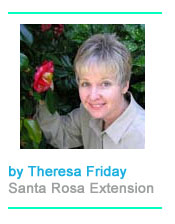 Even though our landscape may be full of rich colors now, it’s time to start thinking about what it will look like in late winter and early spring. Many of our summer flowering annuals are at the end of their life and will be gone with the first frost. Unless you plan now, you may find your winter landscape as dull as a cold winter day.
Even though our landscape may be full of rich colors now, it’s time to start thinking about what it will look like in late winter and early spring. Many of our summer flowering annuals are at the end of their life and will be gone with the first frost. Unless you plan now, you may find your winter landscape as dull as a cold winter day.
Trees and shrubs are somewhat permanent members of our yards. An annual is defined as a plant that produces flowers and seeds within one growing season and then dies. Their purpose is to provide much desired landscape color.
Most cool-season annuals are planted October through November, but we can continue planting into December, January and even February. Most plants will last until April or May if they’re cared for properly.
Bed preparation
Most flowering annual plants will need a well-drained fertile soil. Adding abundant organic matter will help enrich our typically sandy soils in Northwest Florida.
If drainage is a problem, raise the bed. Commercial landscapers plant flowering annuals on beds raised 6 to 12 inches above the surrounding soil. This assures good drainage and improves visibility. When re-planting old beds, remove old mulch to avoid plant diseases. Top new beds with 4 inches of organic matter (such as compost), and work it into the bed about a foot deep.
Annuals differ in sun and shade requirements. Generally, they thrive best in areas that receive sunlight during much of the day. Locate the bed in areas that meet the light requirements of the plants. Remember that soil pH is important for bedding plants. The recommended pH for most bedding plants is 5.4-6.8. Modify soil pH according to soil test recommendations.
Pansies
No other cool-season bedding plant comes close to pansies in popularity. Don’t plant pansies too early in the fall; it’s probably best to wait until we have our first cold snap.
Numerous flower colors and patterns are available. Plant solid colors in masses for the best visual effect.
 Pansies are heavy feeders and will not perform as well without sufficient fertilizer. Apply a small amount of fertilizer at planting and then again in January. If you’d rather, you may mix a teaspoon of slow-release fertilizer into the soil in each hole as you plant them, and you shouldn’t need to apply more fertilizer later. Alternately, you can fertilize once or twice a month with a soluble fertilizer using a hose-end sprayer.
Pansies are heavy feeders and will not perform as well without sufficient fertilizer. Apply a small amount of fertilizer at planting and then again in January. If you’d rather, you may mix a teaspoon of slow-release fertilizer into the soil in each hole as you plant them, and you shouldn’t need to apply more fertilizer later. Alternately, you can fertilize once or twice a month with a soluble fertilizer using a hose-end sprayer.
The pansies you plant now should last until April or early May of next year. To encourage continued flowering over a longer period, pinch off faded flowers if you can.
Snapdragons
Snapdragons are cool season bedding plants that have good flowering performance in late winter and early spring. Plant in full sun, although snapdragons can tolerate some limited afternoon shade.
Tall, medium and short cultivars are available. The tall types are two to three feet tall, the intermediates are one to two feet tall, the bedding types are six to fifteen inches tall, and the rock garden hybrids are about six inches tall
Dianthus
Dianthus have become one of the most reliable cool season bedding plants. They require a slightly higher pH than some other bedding plants. Plant dianthus in full sun. Flower color will be good through the late fall and winter, but the spring flower performance is excellent.
For more information on annual bedding plants, read the University of Florida online publication at http://edis.ifas.ufl.edu/mg319 or call your local Extension Agent.
Theresa Friday is the Residential Horticulture Extension Agent for Santa Rosa County.. Photo credit - David Marshall.
Photos: Molino Park Elementary’s Annual Fall Carnival
October 16, 2010
 Hundreds attended the annual Molino Park Elementary School Fall Carnival Friday evening at the school. The event featured games, food, entertainment and lots of great family fun.
Hundreds attended the annual Molino Park Elementary School Fall Carnival Friday evening at the school. The event featured games, food, entertainment and lots of great family fun.
NorthEscambia.com photos, click to enlarge.
Photos: Jay Homecoming Parade
October 16, 2010
The Jay High School Homecoming Parade rolled through the streets of Jay Friday afternoon.
For a gallery of submitted photos, click here.
Pictured above: The Jay High School sophomore float. Submitted photo for NorthEscambia.com, click to enlarge.
Sarah Campbell Named Jay’s Homecoming Queen
October 16, 2010
Sarah Campbell was named Jay High School’s Homecoming Queen Friday night.
Pictured above: Julie Knight, Homecoming Queen Sarah Campbell, Katie Borders and Leely Trevino — all seniors. Pictured below: Kayla Flowers, freshman attendant; Olivia Wright, sophomore attendant; Sarah Campbell, senior; Julie Knight, senior; Katie Borders, senior; Leely Trevino, senior; and Sara Weaver, junior attendant.Submitted photos by Junia Fischer for NorthEscambia.com, click to enlarge.
Students Learn Ag Safety, Meet Auburn’s Eagles
October 14, 2010
About 500 fifth grade students in Escambia County, Alabama, recently had the opportunity to learn about agricultural safety and see two of Auburn University’s eagles at the same time.
The Progressive Agriculture Safety Days program was presented at the Auburn Experiment Center in Brewton.
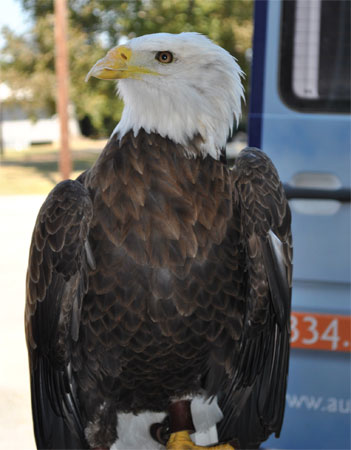 A “Birds of Prey” presentation from the Southeastern Raptor Center from Auburn University included a variety of owls, falcons and hawks. Roy Crowe, AU raptor education specialist and Marianne Murphy Hudson, AU raptor education biologist, presented a variety of birds during the concluding portion of the day’s events. They also had a special surprise, “Spirit”, Auburn University’s bald eagle and “Nova, War Eagle VII”, a golden eagle, were the highlight of the show.
A “Birds of Prey” presentation from the Southeastern Raptor Center from Auburn University included a variety of owls, falcons and hawks. Roy Crowe, AU raptor education specialist and Marianne Murphy Hudson, AU raptor education biologist, presented a variety of birds during the concluding portion of the day’s events. They also had a special surprise, “Spirit”, Auburn University’s bald eagle and “Nova, War Eagle VII”, a golden eagle, were the highlight of the show.
“It is very rare that they bring both eagles to a presentation but after a practice flight in Jordan Hare earlier that morning they decided to surprise them,” said Susan Rhodes from the Escambia County Extension System.
Also included during the Farm Safety Day Program were sessions on Tractor and Lawn Mower Safety presented by the Brewton Agriculture Research Center; Sub Safety presented by Carolyn Bivins with Escambia County Extension Service; Deadly Look-a-Likes/Chemical Safety by Ken Kelly from Escambia County Extension Service; Electrical Safety presented by Jeff Kirkland from Southern Pine Electric Cooperative; ATV Safety from Cynthia Knowelton from the Escambia County Extension Office; Just Say No to Drugs and Meth Awareness by Heath Jackson; 911 and Brewton Fire Department techniques and Safety Tips presented by Kevin Hoomes.
Last week marked the eighth year of the program.
Trike-A-Thon Helps Children’s Hospital
October 13, 2010
 The Camp Fire USA Century Youth Learning Center recently participated in the St. Jude Children’s Research Hospital Trike-A-Thon.
The Camp Fire USA Century Youth Learning Center recently participated in the St. Jude Children’s Research Hospital Trike-A-Thon.
The Trike-A-Thon is designed children riding-toy safety lessons while raising money for St. Jude.
“The children discussed all week how to ride a bicycle safely and how they were helping support a cure for cancer research,” said Pam Townson, director of the Camp Fire USA Century Youth Learning Center. “The children had a wonderful time and were very excited about the event.”
The was the second year that the Camp Fire USA Century Youth Learning Center has taken part in the St. Jude’s Trike-A-Thon.
Submitted photos for NorthEscambia.com, click to enlarge.
NHS Students Win George Washington Honor Medals
October 12, 2010
Northview High School students Katelyn Garrison and Dixie Carnley have been chosen to receive the George Washington Honor Medal for their essays on “What Is Your American Dream?”. The Freedoms Foundation at Valley Forge essay contest was part of Lorenzo Jones’ history class last year at Northview.
The medals will be presented to Garrison and Carnley later this year by the Pensacola Freedoms Foundation Volunteer Chapter.
Pictured above: George Washington Honor Medal winners Katelyn Garrison and Dixie Carnley. NorthEscambia.com photo, click to enlarge.
Molino’s Leaning Post Ranch In The Running For $50K From Pepsi
October 11, 2010
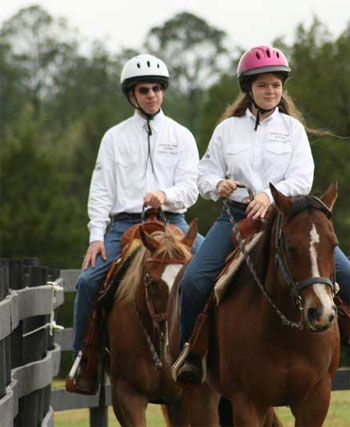 The Leaning Post Ranch in Molino is in the running for $50,000 in funding from the Pepsi Refresh Project.
The Leaning Post Ranch in Molino is in the running for $50,000 in funding from the Pepsi Refresh Project.
The mission of the Leaning Post Ranch is to provide equine assisted activities and therapeutic riding to individuals with disabilities and at-risk youth in Northwest Florida.
“We could grow so much more if we had that much more support and help from our community,” said founder Fran Gersin. She said she hopes The Leaning Post can expand to provide services to anyone in need.
“When I hear kids speak for the first time, or maybe paint or write their name on a horse, or try to walk, or begin to walk, or respond for the first time in an appropriate way, or see an at risk rider overcome their anger and decide they want to get an education — that’s what it’s all about,” Gersin said.
There is a currently a waiting list of 22 riders for The Leaning Post Ranch. With the Pepsi Refresh Project funds, The group plans to expand its staff in order to meet those requests. The $50,000 would allow The Leaning Post to expand weekly therapeutic lessons for disabled riders from 34 to 68 and increase weekly outreach to at-risk youth from eight to 30.
Supporters can vote daily for The Leaning Post Ranch in the Pepsi Refresh Project by clicking here. For more information, visit www.theleaningpostranch.org or view the video below.
NorthEscambia.com file photos, click to enlarge.


